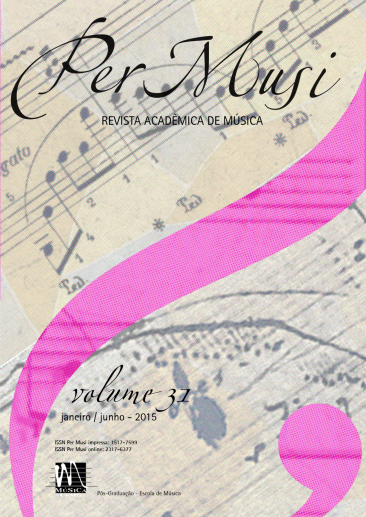Suíte Nº 1 para violoncelo solo de Max Reger e a escrita de J.S. Bach
relações de dependência e identidade de linguagem
Palavras-chave:
Max Reger, J.S. Bach, Suíte para violoncelo solo, Práticas interpretativasResumo
O presente trabalho busca demonstrar como Max Reger emprega modelos de J.S. Bach na construção de sua Suíte Nº 1, Op. 131c. Dessa forma, em sua escrita, Reger combina elementos da harmonia do final do século XIX com técnicas contrapontísticas de J.S. Bach. A influência do mestre barroco é visualizada desde a escolha das tonalidades até a utilização de motivos que são, de fato, transformações e expansões de motivos “bachianos”. Portanto, este trabalho discute as técnicas de composição empregadas por Reger na Suíte Op. 131c nº 1, como também traça um paralelo entre essa obra, em particular, com movimentos das suítes para violoncelo solo de J.S. Bach. A partir dessas premissas, o trabalho propõe subsidiar o intérprete em suas decisões interpretativas.
Referências
CAMPOS, Luz. Yanaina Alvarez. Complexidade e simplicidade: paradoxo na estrutura composicional do Prelúdio da Suíte Nº. 5 para Violoncelo solo de J. S. Bach. Dissertação (Mestrado em Música). Universidade Federal da Paraíba, Centro de Ciências Humanas, Letras e Artes. 2010.
BOTSTEIN, Leon. Notes from the editor: History and Max Reger. In: The Musical Quartely, v. 87, n. 4, p.617-627, winter 2004.
BRINKMANN, Reinhold. A last giant in music: thoughts on Max Reger in the twentieth century. Tradutor: Antonius Bittmann. In: The Musical Quartely, v. 87, n. 4, p.631-659, winter 2004.
DIXON, Gavin. The chamber music of Max Reger. 2008. Disponível em: http://www.gavindixon.info/index.htm. Acesso em 17/12/2012.
FRISH, Walter. Reger’s historicist modernism. In: The Musical Quartely, v. 87, n. 4, p.731-748, winter 2004.
GINSBURG, Lev. The history of the violoncello. Hebert R. Axelrod (ed.). Tradutora: Tanya Tchistyakova. New Jersey: Paganiniana Publications, 1983.
GITTER, Benjamin David. Fugal writing for atypical instrumentation: how Johann Sebastian Bach and Max Reger approached the compositional challenge of composing a fugue for unaccompanied cello. Tese (Doctor of Musical Arts), University of Missouri-Kansas City, 2009.
GRIM, William E. Max Reger: A bio-bibliography. New York: Greenwood Press, 1988.
HUDSON, Richard. “Sarabande”. In: SADIE, Stanley. The New Grove Dictionary of music and musicians. New York: Oxford University Press. Disponível em: http://www.oxfordmusiconline.com/subscriber/article/grove/music/. Acesso em: 04 março 2011.
JOHNSTONE, David. The late-romantic German cello school – an introduction to Julius Klengel and his compositions. In: Articles, Vlc.16, [sd]. Disponível em: <http://www.johnstonemusic.com>. Acesso em: 25 março 2011.
LEDBETTER, David, FERGUSON, Howard. “Prelude”. In: SADIE, Stanley. The New Grove Dictionary of music and musicians. New York: Oxford University Press. Disponível em: http://www.oxfordmusiconline.com/subscriber/article/grove/music/. Acesso em: 25 março 2011.
LITTLE, Meredith., JENNE, Natalie. Dance and the music of J. S. Bach. Bloomington: Indiana University Press, 1998.
NAGLEY, Judith., ANDERSON, Martin. “Reger (Johann Baptist Joseph) Max (Maximilain)”. In: SADIE, Stanley. The New Grove Dictionary of music and musicians New York: Oxford University Press. Disponível em: http://www.oxfordmusiconline.com/subscriber/article/grove/music/. Acesso em: 25 março 2011. TODD, Richard. The sarabandes from J. S. Bach’s Six Suites for Solo Cello: an analysis and interpretive guide for the modern guitarist. Tese (Doctor of Musical Arts) University of North Texas, May, 2007.
Downloads
Publicado
Edição
Seção
Licença
Copyright (c) 2015 Per Musi

Este trabalho está licenciado sob uma licença Creative Commons Attribution 4.0 International License.

Exceto onde está indicado, o conteúdo neste site está sob uma Licença Creative Commons - Atribuição 4.0 Internacional.












